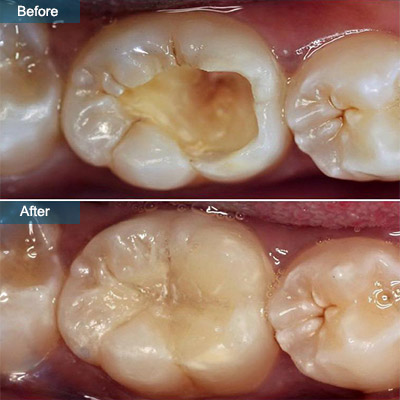The teeth function to mechanically break down items of food by cutting and crushing them in preparation for swallowing and digesting. Humans have four types of teeth: incisors, canines, premolars, and molars, which each have a specific function.
Dental restoration, dental fillings, or simply fillings, are treatments used to restore the function, integrity, and morphology of missing tooth structure resulting from caries or external trauma as well as to the replacement of such structure supported by dental implants.
The process of getting a tooth filling
Once your dentist has assessed your case and determined a tooth filling is the best solution, you will be booked in for your next treatment. In general, a filling treatment can last anywhere roughly between 30 minutes to an hour to complete all the necessary dental work. Most dentists will prepare the area with numbing spray/gel before local anesthetic is used. This creates a more comfortable experience for patients by lessening the feeling of the local anesthetic needle.
Once the area is completely numb, the dentist will remove any decay with a drill and seal the area with a filling. To maintain proper bite function, the dentist will check with the patient to ensure that their bite feels normal. If necessary, part of the filling will be filed down to restore the natural bite. After the treatment, your mouth will be numb for a few hours. During this time, it is not recommended to chew on the numb side of your mouth.
Fillings are a relatively straight forward procedure. However, it is good practice to keep your dentists number on hand in case you experience any discomfort.
Types of Cavity Fillings
Many options are available for tooth fillings, and all of them have their pros and cons. Types of tooth fillings include gold, silver amalgam (a composite of mercury, silver, and other metals), tooth-colored composite material, porcelain, and a special type of glass. The best tooth fillings for you will depend on cost, what your insurance may cover, and your aesthetic preferences.
There is a wide variety of materials used for filling cavities and they vary in strength and color. The two most common types are amalgam and composite.
Amalgam Fillings: Amalgam has been used by dental professionals for more than a century; it is the most researched material used for filling cavities. Amalgam fillings are strong and are therefore ideal for filling cavities in the back of the mouth such as in the molars, where chewing takes place. Since they are made of a combination of several metallic elements, amalgam fillings can be noticeable when you laugh or smile. These fillings are among the least expensive of all cavity-filling materials.
Composite Fillings: Sometimes referred to as composites or filled resins, these fillings feature a combination of glass or quartz filler and can be made to match the color of your tooth. Composite fillings are also fairly durable and are ideal for small-to-mid-size restorations in areas of your mouth that perform moderate chewing.
Metals: Gold or silver amalgam are the most common metals used for a cavity filling. Gold fillings can cost as much as 10 times more than silver amalgam fillings, but some people prefer the appearance of gold to silver fillings if they want the durability of metal vs. a less-durable composite material. Some people don’t like the appearance of metal fillings, but metal fillings can last as long as 10-15 years before they need to be replaced.
Ceramic: A ceramic cavity filling (usually made of porcelain) is tooth-colored, and it may be less likely to show tooth stains over time than a composite cavity filling. But price is a factor—a ceramic filling can be nearly as expensive as a gold cavity filling.
Glass Ionomer: This blend of acrylic and glass is used to create a cavity filling that releases fluoride to help protect teeth. But a glass ionomer cavity filling is less durable than other types, and may need to be replaced in as little as five years. SEE: What Does a Pediatric Dentist Do?
Taking Care of Cavity Fillings
You may experience some sensitivity and pain after receiving tooth fillings, but this discomfort should subside. Don’t neglect your oral care routine. Instead, try products designed specifically to protect sensitive teeth.
Potential Problems with Cavity Fillings
It’s important to know about potential problems, so you can see your dentist promptly to have cavity fillings adjusted or repaired. Possible complications from cavity fillings include:
Infection: Sometimes a cavity filling will pull away from the tooth to which it is attached, creating a small space. This space can be a breeding ground for bacteria that can cause additional tooth decay. If you notice a space between your tooth and your cavity filling, visit a dentist as soon as possible.
Damage: Sometimes a cavity filling breaks, cracks, or falls out. Damage to a filling can occur when you bite down on something hard or if you are hit in the mouth while playing sports. See a dentist as soon as you notice damage to a cavity filling to avoid irritation and infection of the unprotected tooth.
How much does a tooth filling cost in Nigeria?
Usually, a filling will last anywhere from 7-20 years, although this depends on the location of the filling, the size, and your dental hygiene. Fillings put up with a lot of stress! Every time you chew, your filling is compromised. Factors like extensive tooth decay, location of clinic, the number of fillings required can increase the cost of tooth filling. Dental clinics in Nigeria charge between =N= 10,000 and =N= 50,000 government hospitals usually charge less than private dental clinics. SEE: List of Dental Instruments Names and Functions





